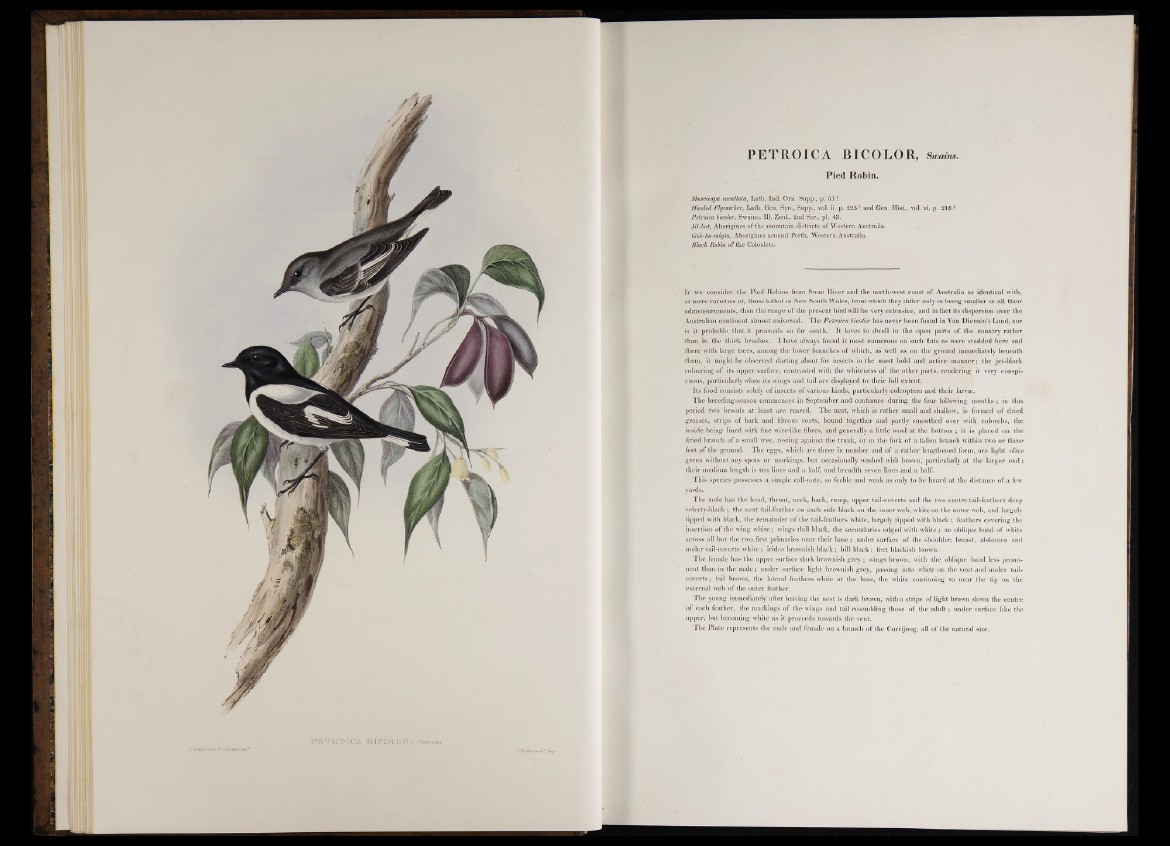
PETROICA BICOLOR, Swains.
Pied Robin.
Muscicapa cuculiata, Lath. Ind. Om. Supp., p. 51 ?
Hooded Flycatcher, Lath. Gen. Syn., Supp., vol. ii. p. 223 ? and Gen. Hist., vol. vi. p. 216 ?
Petroica bicolor, Swains. 111. Zool., 2nd Ser., pi. 43.
Jil-but, Aborigines of the mountain districts of Western Australia.
Goo-ba-mógin, Aborigines around Perth, Western Australia.
Black Robin of the Colonists.
I f we consider the Pied Robins from Swan River and the north-west coast of Australia as identical with,
or mere varieties of, those killed in New South Wales, from which they differ only in being smaller in all their
admeasurements, then the range of the present bird will be very extensive, and in fact its dispersion over the
Australian continent almost universal. The Petroica bicolor has never been found in Van Diemen’s Land, nor
is it probable that it proceeds so far south. It loves to dwell in the open parts of the country rather
than in the thick brushes. I have always found it most numerous on such flats as were studded here and
there with large trees, among the lower branches of which, as well as on the ground immediately beneath
them, it might be observed darting about for insects in the most bold and active manner; the jet-black
colouring of its upper surface, contrasted with the whiteness of the other parts, rendering it very conspicuous,
particularly when its wings and tail are displayed to their full extent.
Its food consists solely of insects of various kinds, particularly coleoptera and their larvee.
The breeding-season commences in September and continues during the four following months ; in this
period two broods at least are reared. The nest, which is rather small and shallow, is formed o f dried
grasses, strips of bark and fibrous roots, bound together and partly smoothed over with cobwebs, the
inside being lined with fine wire-like fibres, and generally a little wool at the bottom ; it is placed on the
dried branch of a small tree, resting against the trunk, or in the fork of a fallen branch within two or three
feet pf the ground. The eggs, which are three in number and of a rather lengthened form, are light olive
green without any spots or markings, but occasionally washed with brown, particularly at the larger en d ;
their medium length is ten lines and a half, and breadth seven lines and a half.
This species possesses a simple call-note, so feeble and weak as only to be heard at the distance of a few
yards.
The male has the head, throat, neck, back, rump, upper tail-coverts and the two centre tail-feathers deep
velvety-black ; the next tail-feather on each side black on the inner web, white on the outer web, and largely
tipped with black, the remainder of the tail-feathers white, largely tipped with black; feathers covering the
insertion of the wing white; wings dull black, the secondaries edged with white; an oblique band o f white
across all but the two. first primaries near their base; under surface of the shoulder, breast, abdomen and
under tail-coverts white ; irides brownish black; bill black; feet blackish brown.
The female has the upper surface dark brownish grey ; wings brown, with the oblique band less prominent
than in the male; under surface light brownish grey, passing into white on the vent and under tail-
coverts ; tail brown, the lateral feathers white at the base, the white continuing to near the tip on the
external web of the outer feather.
The young immediately after leaving the nest is dark brown, with a stripe o f light brown down the centre
of each feather, the markings o f the wings and tail resembling those of the adult; under surface like the
upper, but becoming white as it proceeds towards the vent.
The Plate represents the male and female on a branch of the Currijong, all of the natural size.